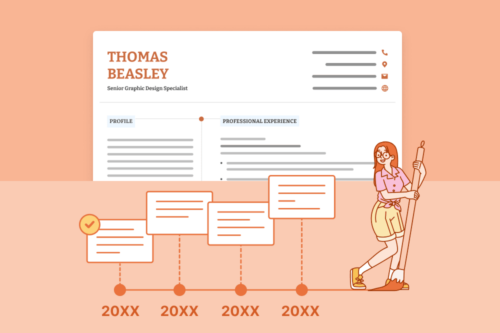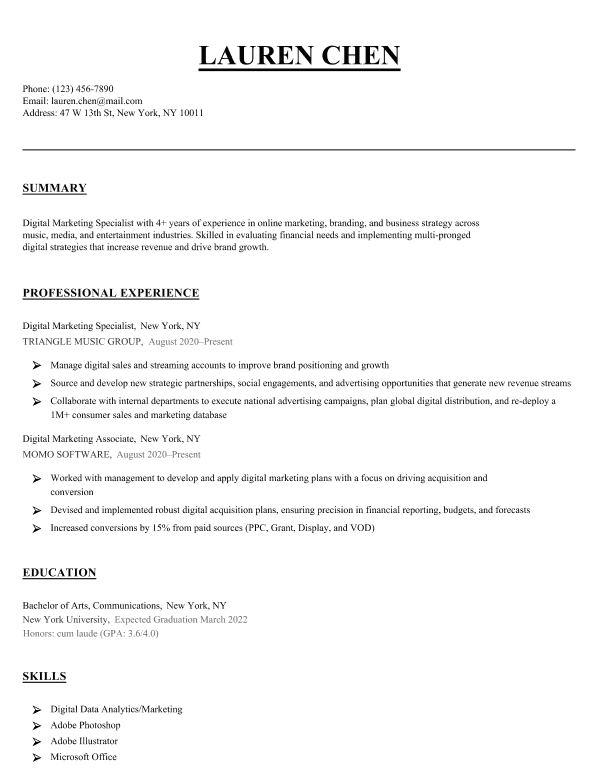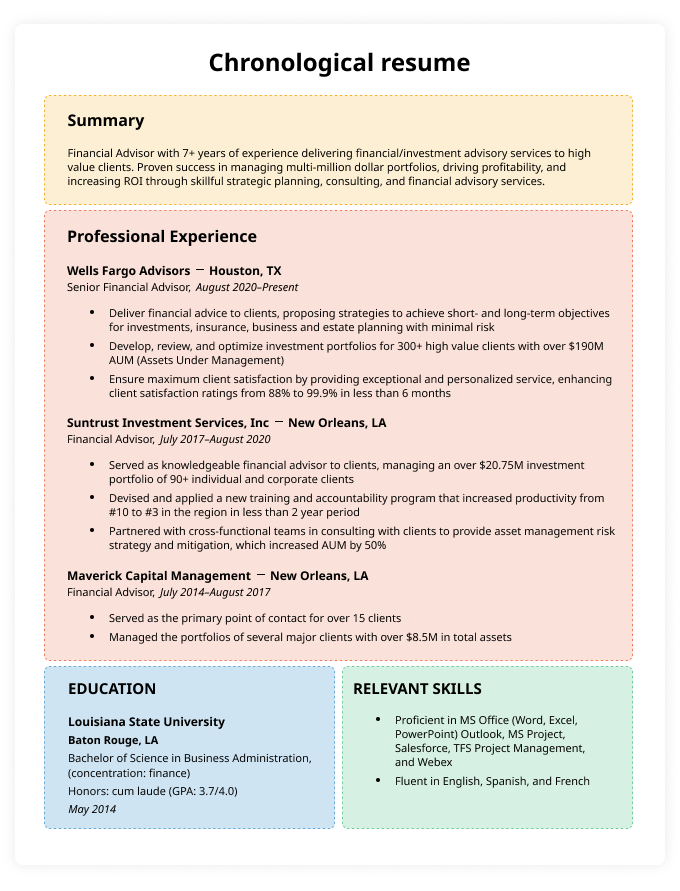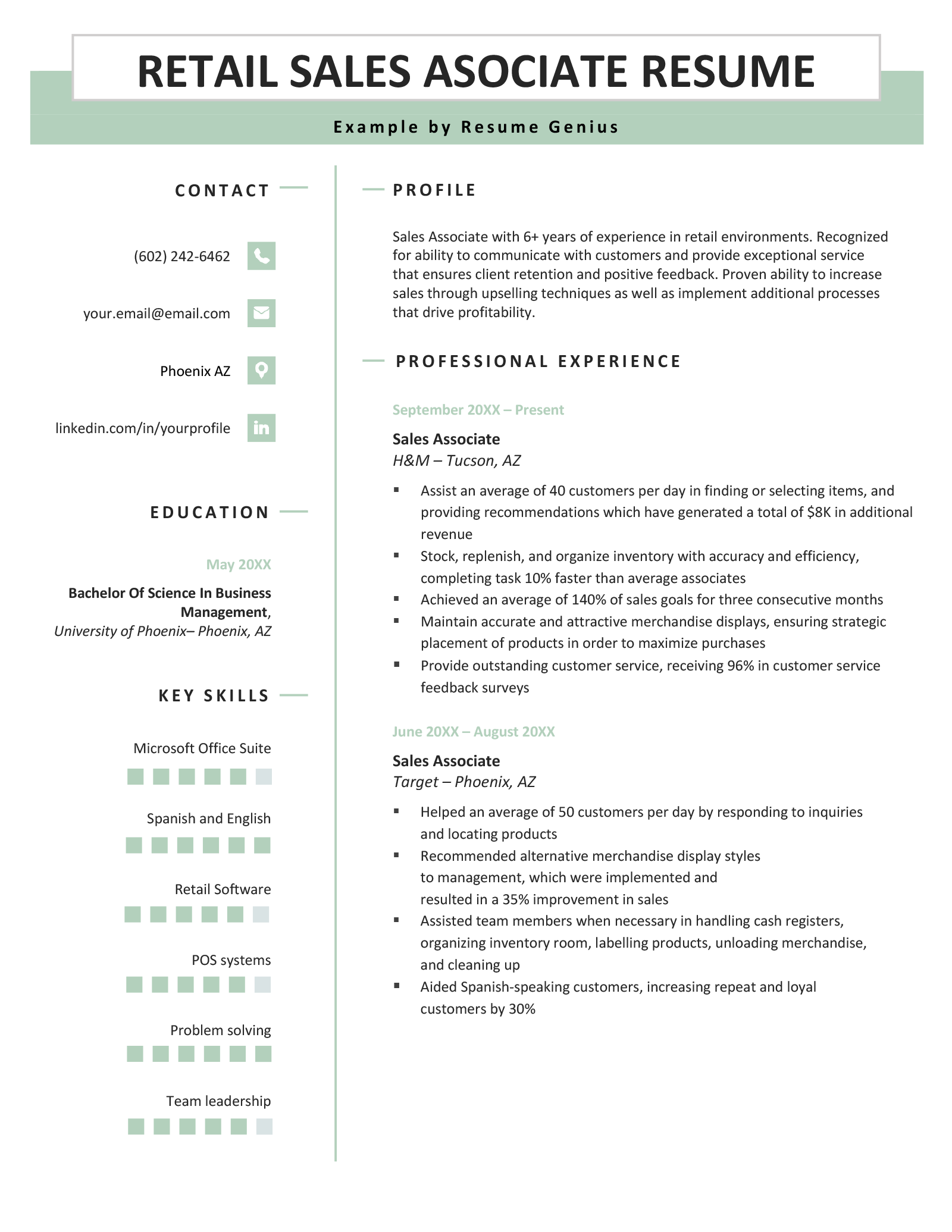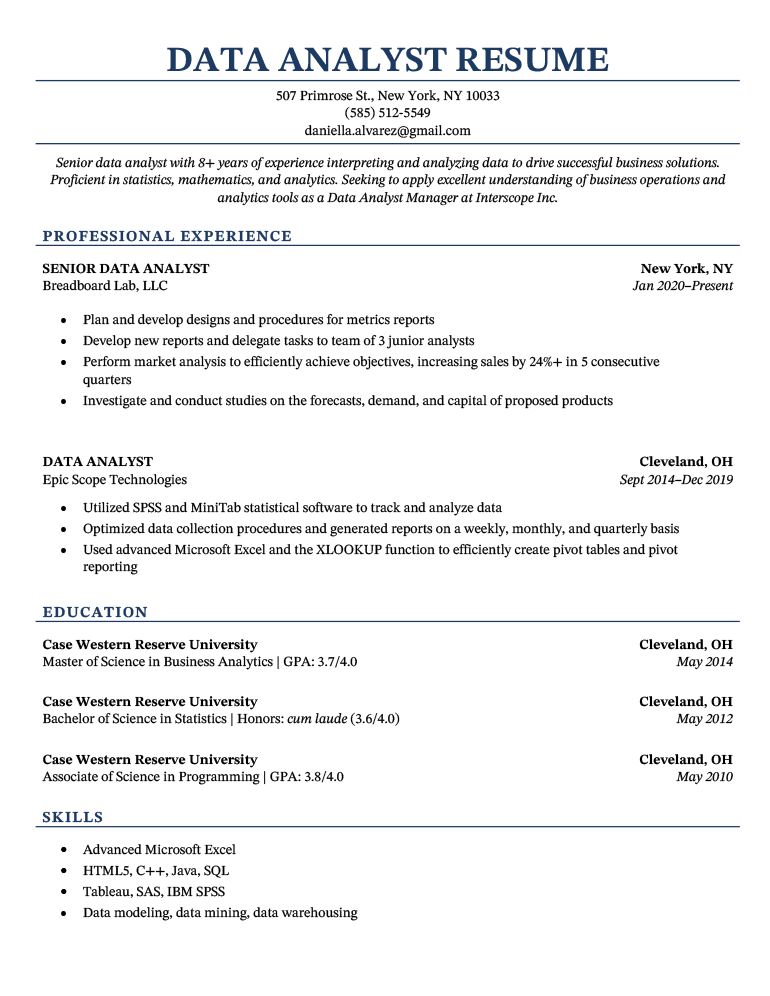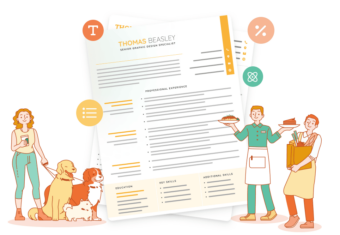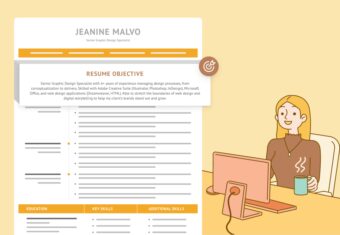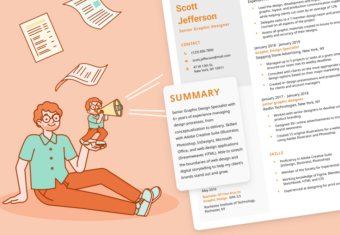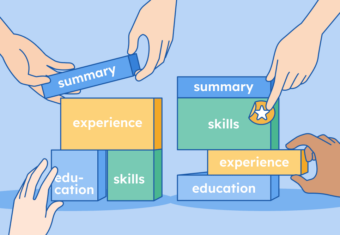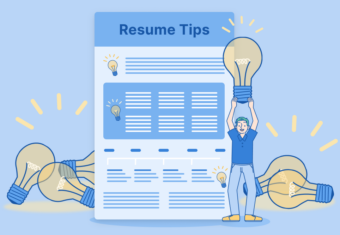In this article, we’ll break down everything you need to know about chronological resumes and provide the template, examples, and tips you need to get started.
Our free-to-use resume builder can make you a resume in as little as 5 minutes. Just pick the template you want, and our software will format everything for you.
What is a chronological resume?
A chronological resume is a standard resume format that lists your work history in reverse-chronological order, starting with your most recent job listed at the top and each previous position in descending order.
The chronological resume continues to be the most popular format in 2024 because it accommodates people with any experience level and presents your qualifications in a logical, time-ordered fashion that’s easy for a hiring manager to read, as our expert CPRW, Eva Chan, explains:
You may want to avoid using a chronological resume if you have gaps in your work history or have frequently changed jobs. In these cases, consider using a functional resume (skills-based resume) or the hybrid combination format.
Chronological resume format
Here’s what a chronological resume format looks like:
Chronological resume template
Ordering your sections properly is important when writing a chronological resume.
To ensure you order your chronological resume correctly, here’s a resume template you can copy and paste into Google Docs or Microsoft Word and fill in with your information:
1. Resume Heading
FIRST AND LAST NAME
Email: youremail@gmail.com | Phone: 908 555 555 | Address: 118 Washington Ave., New York, NY 10280 | Linkedin: linkedin.com/in/yourprofile
2. Resume Introduction
Passionate [industry] professional with [# of years] years of experience. Seeking to use my expertise in [relevant skills] to fill the [position name] position at [Company’s Name]. A dedicated worker aiming to help contribute to [Company’s Name]’s goals and take on more responsibility as quickly as possible.
3. Work or Relevant Experience
Most Recent Job Title
Employer Name / Location / Start Date – End Date
- Include a bulleted list of your accomplishments and responsibilities
- Unless this is your only job, avoid using more than five bullet points
- Add numbers (such as percentages or dollar amounts) to these bullet points to illustrate your specific achievements
Earlier Job Title
Employer Name / Location / Start Date – End Date
- List relevant accomplishments from an earlier job
- Assuming you no longer hold this job, use past tense verbs to describe your achievements
4. Education
Degree Name / Major
University, Location | Start Date – End Date
5. Skills and Certifications
- List your relevant skills and certifications
- Include a range of hard skills and soft skills
- Specify the actual names of software or tools you can use
6. Additional Resume Section
- Here’s where you can add any other relevant information
- For example, this section could be for any of the following: publications, languages, volunteer experience, or even hobbies
Chronological resume examples
Want to see this format in action? Here are three examples of chronological resumes you can download and use for reference:
1. Chronological resume example for a financial advisor
Here’s a financial advisor resume that uses a chronological format, featuring the candidate’s experience in the center of the page:
2. Chronological resume example for a retail sales associate
This retail sales associate resume features a side bar including the candidate’s contact information, education, and skills, with a chronologically ordered professional experience section.
3. Chronological resume example for a data analyst
This resume from a data analyst puts heavy emphasis on the work experience and education sections, which both list details in reverse-chronological order.
Want to see some more examples? View chronological resume examples from your industry to see how yours should look.
How to order a chronological resume
Here’s how to write a resume according to the chronological format:
1. List your contact information
To ensure the hiring manager can contact you, include the following four pieces of information in your chronological resume header:
- First and last name
- Email address
- Phone number
- LinkedIn profile
Note that while adding a mailing address to your resume used to be standard practice, it’s no longer necessary because most employers will contact you via email.
2. Open with a strong resume introduction
One of the best ways to get employers’ attention is by starting your resume with a convincing introduction.
You can choose to either write a resume objective or summary.
Resume objective
Resume objectives are typically for candidates just starting their career. You’ll need to list any relevant qualifications you currently have and end with a statement that shows the hiring manager you’re dedicated and will quickly adapt to your new position.
Here’s an example of a nursing resume objective on a chronological resume:
Hardworking recent-graduate RN with over a year of clinical internship experience helping treat patients with chronic illnesses and monitoring vitals. Possess a BSN and BLS certification. Seeking to leverage my skills and qualifications to fill the RN position at Brandywine Hospital.
Resume summary
On the other hand, a resume summary is typically meant for candidates with several years of experience, and acts as a highlight reel for your career achievements. In a few sentences, it provides a quick overview of your relevant qualifications, goals, and most valuable skills.
Here’s an example of a resume summary for an administrative assistant on a chronological resume:
Administrative Assistant with 2+ years of experience preparing flawless presentations, assembling facility reports, and maintaining the utmost confidentiality. Possesses a B.A. in History and expertise in Microsoft Excel. Looking to leverage my knowledge and experience into a role as a Project Manager.
Use an online resume summary generator to help you write your resume summary if you’re not sure how best to showcase your achievements.
3. Write your work experience in reverse-chronological order
Work experience is the core of a chronological resume, so put some time into writing this section.
List each relevant job you’ve held in reverse-chronological order, with your most recent position at the top. Under each position, provide three to five bullet points outlining your primary duties and responsibilities. Use the present resume tense for your current position and the past tense for previous job titles.
Remember to add hard numbers to your bullet points to make your accomplishments measurable for a hiring manager to see and better understand how you contributed to previous employers.
Additionally, start each bullet point with an action verb to make your work experience more engaging to read. Using action verbs will give the impression you’re proactive at work and make it easier for the HR manager to understand exactly what you can achieve on the job.
Here’s an example of a work experience section on a chronological resume that uses hard numbers and action verbs:
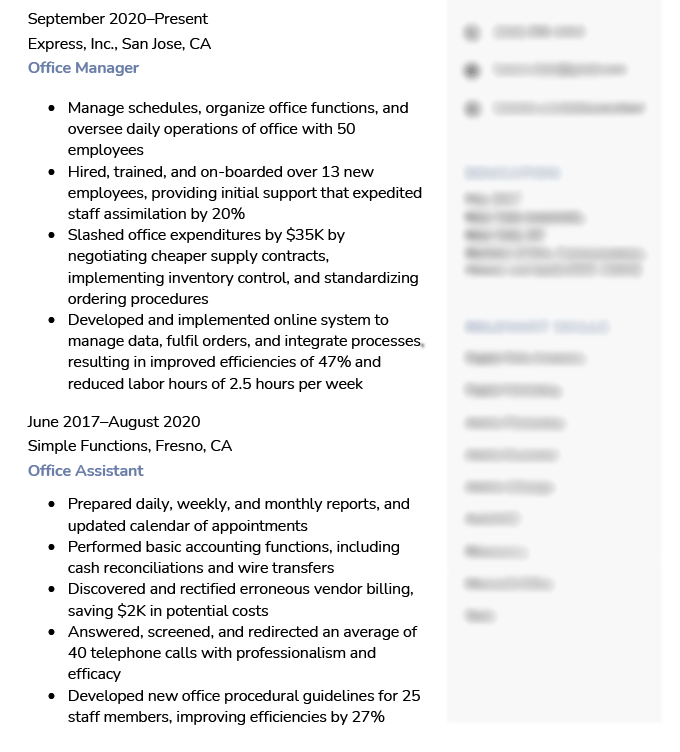
4. Include a brief education section
For most candidates, the resume education section will be short and simple, including only the following three pieces of information:
- university name and location
- degree or certification name
- graduation date
Here’s what an education section looks like in practice:

However, suppose you’re a college student or will be graduating soon. In that case, you may want to include additional information in your education section to increase your value as a candidate, such as your GPA (if it’s higher than 3.5), Dean’s list, relevant coursework, extracurricular activities, and other academic awards.
Here’s an example of a recent graduate‘s education section on a chronological resume:
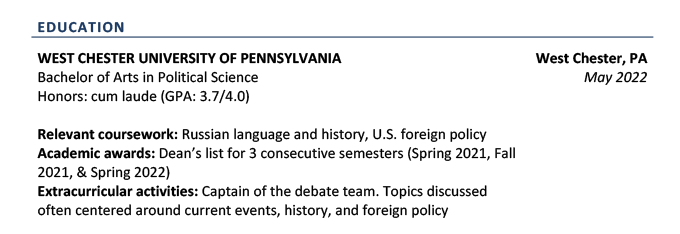
5. List your skills
No chronological resume is complete without a skills section. Here, you’ll need to list any hard or soft skills you didn’t have an opportunity to give examples of in your work experience section.
However, remember to keep it clear and concise, only including skills on your resume directly relevant to the job you’re applying to.
If you’re not sure which skills to include, look at the position’s job description. Usually, employers spell out the exact qualifications they’re looking for in the “Responsibilities” section of their listing.
Here’s an example real estate agent‘s skills section on a chronological resume:
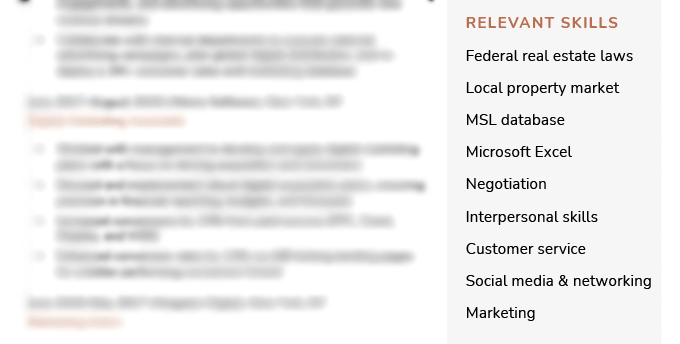
If you’re well into your career and you want a resume that equally emphasizes your skills and work experience, then writing a hybrid resume instead may be your best choice
Frequently asked questions about chronological resumes
Still unsure about chronological resumes? Check out our answers to some of the most common questions below.
Should resumes be in chronological order or reverse?
Resumes should list experience starting with your current or most recent position, working backwards through your professional history.
Technically this is called reverse-chronological order. However when people reference “chronological” or “reverse-chronological” resumes, they mean the same thing.
What is a reverse-chronological order resume?
A reverse-chronological order resume is a resume format that lists your work experiences in reverse-chronological order, starting with the most recent position at the top and moving backward.
The reverse-chronological format highlights your latest and most relevant experiences, making it easier for employers to see your career trajectory and qualifications quickly.
When should you use a chronological resume?
The vast majority of job seekers should use a chronological resume, as it’s suitable for any experience level and is what hiring managers are most accustomed to looking at.
Chronological resumes are perfect for highlighting career progression and are particularly advantageous when your work history aligns with the job you’re applying for, showing a logical advancement of skills and responsibilities over time.
What is the difference between a chronological resume and a functional resume?
Chronological and functional resumes differ in their structure and focus.
A chronological resume emphasizes your work history, listing experiences in reverse-chronological order, while a functional resume focuses on your skills and qualifications, grouping them by function instead of presenting a chronological timeline.
Functional resumes can be useful for job seekers with employment gaps, frequent job changes, or any other resume red flags that can be minimized by using a functional resume.
When is a chronological resume not advantageous?
A chronological resume may not be advantageous if you have significant gaps in your work history or a history of frequent job changes. In such cases, a functional resume (skills-based) or a hybrid combination format might be a better option for showcasing your qualifications.
Click to rate this article
4.3 Average rating


